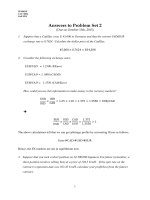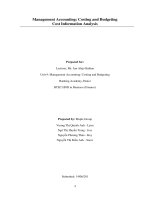Assignment 2 Networking (1619 Distinction)
Bạn đang xem bản rút gọn của tài liệu. Xem và tải ngay bản đầy đủ của tài liệu tại đây (7.22 MB, 59 trang )
ASSIGNMENT 2 FRONT SHEET
Qualification
BTEC Level 5 HND Diploma in Computing
Unit number and title
Unit 2: Networking Infrastructure
Submission date
Date Received 1st submission
Re-submission Date
Date Received 2nd submission
Student Name
Bui Quang Minh
Student ID
GCD210325
Class
GCD1104
Assessor name
Tran Trong Minh
Student declaration
I certify that the assignment submission is entirely my own work and I fully understand the consequences of plagiarism. I understand that making a false declaration is a form
of malpractice.
Student’s signature
Grading grid
P5
P6
P7
P8
M3
M4
D2
D3
Minh
Summative Feedback:
Grade:
Lecturer Signature:
Assessor Signature:
Resubmission Feedback:
Date:
Table of Contents
TASK 1: LOGICAL/PHYSICAL DESIGN OF NETWORED SYSTEM (P5) .......................................................... 5
I. DIFFERENCES ........................................................................................................................................ 5
II. USER REQUIREMENTS ......................................................................................................................... 6
III. LOGICAL DESIGN ................................................................................................................................ 7
IV. PHYSICAL DESIGN ............................................................................................................................... 7
1. Ground floor ..................................................................................................................................... 9
2. First floor .......................................................................................................................................... 10
3. Second floor ..................................................................................................................................... 10
V. ADDRESS TABLE .................................................................................................................................. 11
TASK 2: DESIGN EVALUATION (P6) ......................................................................................................... 16
I. TEST PLAN ............................................................................................................................................ 16
II. EVALUATION ....................................................................................................................................... 18
TASK 2.1: INSTALLATION AND CONFIGURATION (M3) ........................................................................... 19
I. OVERVIEW OF SERVER ......................................................................................................................... 19
1. Definition …....................................................................................................................................... 19
2. Why we need them .......................................................................................................................... 19
II. CONFIGURATION OF DHCP_DNS SERVER ............................................................................................ 20
III. CONFIGURATION OF WEB SERCER ..................................................................................................... 23
IV. CONFIGURATION OF MAIL SERCER .................................................................................................... 24
V. CONFIGURATION OF FILE SERCER ...................................................................................................... 26
TASK 2.1.1: MAINTENANCE SCHEDULA (D2) ........................................................................................... 28
I. DESIGN NETWORK MAINTENANCE ...................................................................................................... 28
II. BENEFITS OF NETWORK MAINTENANCE ............................................................................................. 28
TASK 3: IMPLEMENT A NETWORK SYSTEM (P7) ...................................................................................... 30
I. PROOFING OF NETWORK IMPLEMENTATION ....................................................................................... 30
1. Setting for computers ....................................................................................................................... 30
2. Setting for servers ............................................................................................................................. 31
3. Setting for printers ........................................................................................................................... 33
4. Setting for routers ............................................................................................................................ 35
5. Setting for switch .............................................................................................................................. 36
II. DIAGRAM ............................................................................................................................................. 38
TASK 4: DOCUMENT AND ANALYSE TEST RESULTS (P8) ........................................................................... 35
I. CONFIGURATION SHOWING .................................................................................................................. 35
1. Multiple switch D1 ……....................................................................................................................... 35
2. Swich ................................................................................................................................................. 41
3. Routers R1 ......................................................................................................................................... 48
II. TESTING ................................................................................................................................................ 49
TASK 4.1: POTENTIAL ENHANCEMENTS (M4) ........................................................................................... 58
REFERENCE …………………………………………………………………………………………………………………………….…………… 59
TASK1: LOGICAL/PHYSICAL DESIGN OF NETWORKED SYSTEM
(P5)
I. DIFFERENCE BETWEEN TWO DESIGNS
A logical topology is how devices appear connected to the user. A physical topology is how they are
actually interconnected with wires and cables.
Logical design. The objective of the logical design phase is to reach, starting from the conceptual
scheme, a logical scheme that represents it faithfully, “efficiently” and independent of the
particular DBMS (Data Base Management System) adopted. To this end, this design phase can be
divided into 2 steps:
Restructuring of the Entity-Relationship scheme: it is a phase independent of the logical model and
is based on optimization criteria of the scheme;
Translation towards the logical model: it refers to a specific logical model, in our case the relational
model.
Physical design. It translates the logical schema in terms of tables and relationships that will
constitute the actual physical structure of the database. This last phase will be taken into
consideration in this thesis in a marginal way.
Figure 1. Logical Design Compared with Physical Design
II. USER REQUIREMENTS FOR GENERAL NETWORK DESIGN
1. User Request:
People: People: 200 students, 15 teachers, 12 marketing and administration staff, 5 higher
managers, including the head of academics and the program manager, 3 computer network
administrators.
Resources: 50 student lab computers, 35 staff computers, 3 printers.
Building: 3 floors, all computers and printers are on the ground floor apart from the IT labs –
one lab located on the first floor and another located on the second floor.
Explain the USER Requirement:
CEO Mr. Nguyen’s institution
Seconds Floor
•
Lab room 2: 25 computers (ITLab26 – ITLab50)
First Floor
•
Lab room 1: 25 computers (ITLab01 – ITLab25)
Ground Floor
•
Network administrators’ room: 3 computers.
•
Managers’ room: 5 computers and 1 printer.
•
Staff room: 12 computers and 1 printer.
•
Teachers’ room: 15 computers and 1 printer.
III. LOGICAL DESIGN
The logical network design is composed of segregated networks that are implemented physically
using virtual local area networks (VLANs) defined by network switches
Figure 2. Logical topology
IV. PHYSICAL DESIGN
The physical network design as the name implies, is the physical components used for installation.
Physical layout of a network is the hardware on which the network topology is built. The elements
of a physical network design consist of routers, cables, connecting cables, laptops, desktops,
switches
Figure 3. Physical topology of ground floor
1. Ground floor
Figure 4. Physical topology of ground floor
Figure 5. Physical topology of ground floor (2)
2. First floor
Figure 6. Physical topology of 1st floor
3. Second floor
Figure 7. Physical topology of 2nd floor
V. ADDRESS TABLE
Device
Interface
Address
Subnet Mask
Default Gateway
VLAN
R1
S0/0/0
192.10.10.2
255.255.255.0
N/A
N/A
G/0/0.10
192.168.10.1
255.255.255.0
N/A
10
G/0/0.20
192.168.20.1
255.255.255.0
N/A
20
G/0/0.30
192.168.30.1
255.255.255.0
N/A
30
G/0/0.40
192.168.40.1
255.255.255.0
N/A
40
G/0/0.50
192.168.50.1
255.255.255.0
N/A
50
G/0/0.60
192.168.60.1
255.255.255.0
N/A
60
G/0/0.70
192.168.70.1
255.255.255.0
N/A
70
G/0/0.99
192.168.99.1
255.255.255.0
N/A
99
D1
VLAN 99
192.168.99.200
255.255.255.0
192.168.99.1
99
S-Server
VLAN 99
192.168.99.11
255.255.255.0
192.168.99.1
99
S-ComNet
VLAN 99
192.168.99.21
255.255.255.0
192.168.99.1
99
S-MarketAdmin
VLAN 99
192.168.99.31
255.255.255.0
192.168.99.1
99
S-Teacher
VLAN 99
192.168.99.41
255.255.255.0
192.168.99.1
99
S-Manager
VLAN 99
192.168.99.51
255.255.255.0
192.168.99.1
99
S_ITLab1_1
VLAN 99
192.168.99.61
255.255.255.0
192.168.99.1
99
S_ ITLab1_2
VLAN 99
192.168.99.62
255.255.255.0
192.168.99.1
99
S_ ITLab2_1
VLAN 99
192.168.99.71
255.255.255.0
192.168.99.1
99
S_ ITLab2_2
VLAN 99
192.168.99.72
255.255.255.0
192.168.99.1
99
DHCP-DNS
NIC
192.168.10.2
255.255.255.0
192.168.10.1
10
Web
NIC
192.168.10.3
255.255.255.0
192.168.10.1
10
NIC
192.168.10.4
255.255.255.0
192.168.10.1
10
File
NIC
192.168.10.5
255.255.255.0
192.168.10.1
10
ComNet01
NIC
192.168.20.11
255.255.255.0
192.168.30.1
20
ComNet02
NIC
192.168.20.12
255.255.255.0
192.168.30.1
20
ComNet03
NIC
192.168.20.13
255.255.255.0
192.168.30.1
20
MA01
NIC
192.168.30.11
255.255.255.0
192.168.30.1
30
MA02
NIC
192.168.30.12
255.255.255.0
192.168.30.1
30
MA03
NIC
192.168.30.13
255.255.255.0
192.168.30.1
30
MA04
NIC
192.168.30.14
255.255.255.0
192.168.30.1
30
MA05
NIC
192.168.30.15
255.255.255.0
192.168.30.1
30
MA06
NIC
192.168.30.16
255.255.255.0
192.168.30.1
30
MA07
NIC
192.168.30.17
255.255.255.0
192.168.30.1
30
MA08
NIC
192.168.30.18
255.255.255.0
192.168.30.1
30
MA09
NIC
192.168.30.19
255.255.255.0
192.168.30.1
30
MA10
NIC
192.168.30.20
255.255.255.0
192.168.30.1
30
MA11
NIC
192.168.30.21
255.255.255.0
192.168.30.1
30
MA12
NIC
192.168.30.22
255.255.255.0
192.168.30.1
30
P_MarketAdmin
NIC
N/A
N/A
192.168.30.1
30
T01
NIC
192.168.40.11
255.255.255.0
192.168.40.1
40
T02
NIC
192.168.40.12
255.255.255.0
192.168.40.1
40
T03
NIC
192.168.40.13
255.255.255.0
192.168.40.1
40
T04
NIC
192.168.40.14
255.255.255.0
192.168.40.1
40
T05
NIC
192.168.40.15
255.255.255.0
192.168.40.1
40
T06
NIC
192.168.40.16
255.255.255.0
192.168.40.1
40
T07
NIC
192.168.40.17
255.255.255.0
192.168.40.1
40
T08
NIC
192.168.40.18
255.255.255.0
192.168.40.1
40
T09
NIC
192.168.40.19
255.255.255.0
192.168.40.1
40
T10
NIC
192.168.40.20
255.255.255.0
192.168.40.1
40
T11
NIC
192.168.40.21
255.255.255.0
192.168.40.1
40
T12
NIC
192.168.40.22
255.255.255.0
192.168.40.1
40
T13
NIC
192.168.40.23
255.255.255.0
192.168.40.1
40
T14
NIC
192.168.40.24
255.255.255.0
192.168.40.1
40
T15
NIC
192.168.40.25
255.255.255.0
192.168.40.1
40
P_Teacher
NIC
N/A
N/A
192.168.40.1
40
M01
NIC
192.168.50.11
255.255.255.0
192.168.50.1
50
M02
NIC
192.168.50.12
255.255.255.0
192.168.50.1
50
M03
NIC
192.168.50.13
255.255.255.0
192.168.50.1
50
M04
NIC
192.168.50.14
255.255.255.0
192.168.50.1
50
M05
NIC
192.168.50.15
255.255.255.0
192.168.50.1
50
P_Manager
NIC
N/A
N/A
192.168.50.1
50
ITL01
NIC
192.168.60.11
255.255.255.0
192.168.60.1
60
ITL02
NIC
192.168.60.12
255.255.255.0
192.168.60.1
60
ITL03
NIC
192.168.60.13
255.255.255.0
192.168.60.1
60
ITL04
NIC
192.168.60.14
255.255.255.0
192.168.60.1
60
ITL05
NIC
192.168.60.15
255.255.255.0
192.168.60.1
60
ITL06
NIC
192.168.60.16
255.255.255.0
192.168.60.1
60
ITL07
NIC
192.168.60.17
255.255.255.0
192.168.60.1
60
ITL08
NIC
192.168.60.18
255.255.255.0
192.168.60.1
60
ITL09
NIC
192.168.60.19
255.255.255.0
192.168.60.1
60
ITL10
NIC
192.168.60.20
255.255.255.0
192.168.60.1
60
ITL11
NIC
192.168.60.21
255.255.255.0
192.168.60.1
60
ITL12
NIC
192.168.60.22
255.255.255.0
192.168.60.1
60
ITL13
NIC
192.168.60.23
255.255.255.0
192.168.60.1
60
ITL14
NIC
192.168.60.24
255.255.255.0
192.168.60.1
60
ITL15
NIC
192.168.60.25
255.255.255.0
192.168.60.1
60
ITL16
NIC
192.168.60.26
255.255.255.0
192.168.60.1
60
ITL17
NIC
192.168.60.27
255.255.255.0
192.168.60.1
60
ITL18
NIC
192.168.60.28
255.255.255.0
192.168.60.1
60
ITL19
NIC
192.168.60.29
255.255.255.0
192.168.60.1
60
ITL20
NIC
192.168.60.30
255.255.255.0
192.168.60.1
60
ITL21
NIC
192.168.60.31
255.255.255.0
192.168.60.1
60
ITL22
NIC
192.168.60.32
255.255.255.0
192.168.60.1
60
ITL23
NIC
192.168.60.33
255.255.255.0
192.168.60.1
60
ITL24
NIC
192.168.60.34
255.255.255.0
192.168.60.1
60
ITL25
NIC
192.168.60.35
255.255.255.0
192.168.60.1
60
ITL26
NIC
192.168.70.36
255.255.255.0
192.168.70.1
70
ITL27
NIC
192.168.70.37
255.255.255.0
192.168.70.1
70
ITL28
NIC
192.168.70.38
255.255.255.0
192.168.70.1
70
ITL29
NIC
192.168.70.39
255.255.255.0
192.168.70.1
70
ITL30
NIC
192.168.70.40
255.255.255.0
192.168.70.1
70
ITL31
NIC
192.168.70.41
255.255.255.0
192.168.70.1
70
ITL32
NIC
192.168.70.42
255.255.255.0
192.168.70.1
70
ITL33
NIC
192.168.70.43
255.255.255.0
192.168.70.1
70
ITL34
NIC
192.168.70.44
255.255.255.0
192.168.70.1
70
ITL35
NIC
192.168.70.45
255.255.255.0
192.168.70.1
70
ITL36
NIC
192.168.70.46
255.255.255.0
192.168.70.1
70
ITL37
NIC
192.168.70.47
255.255.255.0
192.168.70.1
70
ITL38
NIC
192.168.70.48
255.255.255.0
192.168.70.1
70
ITL39
NIC
192.168.70.49
255.255.255.0
192.168.70.1
70
ITL40
NIC
192.168.70.50
255.255.255.0
192.168.70.1
70
ITL41
NIC
192.168.70.51
255.255.255.0
192.168.70.1
70
ITL42
NIC
192.168.70.52
255.255.255.0
192.168.70.1
70
ITL43
NIC
192.168.70.53
255.255.255.0
192.168.70.1
70
ITL44
NIC
192.168.70.54
255.255.255.0
192.168.70.1
70
ITL45
NIC
192.168.70.55
255.255.255.0
192.168.70.1
70
ITL46
NIC
192.168.70.56
255.255.255.0
192.168.70.1
70
ITL47
NIC
192.168.70.57
255.255.255.0
192.168.70.1
70
ITL48
NIC
192.168.70.58
255.255.255.0
192.168.70.1
70
ITL49
NIC
192.168.70.59
255.255.255.0
192.168.70.1
70
ITL50
NIC
192.168.70.60
255.255.255.0
192.168.70.1
70
TASK 2: DESIGN EVALUATION (P6)
I. TEST PLAN
Test ID
Test case
Expected Outcome
1
Ping from host to host in
VLAN 10
Successful
2
Ping from host to host in
VLAN 20
Successful
3
Ping from host to host in
VLAN 30
Successful
4
Ping from host to host in
VLAN 40
Successful
5
Ping from host to host in
VLAN 50
Successful
6
Ping from host to host in
VLAN 60
Successful
7
Ping from host to host in
VLAN 70
Successful
8
Ping from switch to switch
in VLAN 99
Successful
9
Ping from VLAN 10 to
default gateway
Successful
10
Ping from VLAN 20 to
default gateway
Successful
11
Ping from VLAN 30 to
default gateway
Successful
12
Ping from VLAN 40 to
default gateway
Successful
13
Ping from VLAN 50 to
default gateway
Successful
14
Ping from VLAN 60 to
default gateway
Successful
Actual
Outcome
Remarks
15
Ping from VLAN 70 to
default gateway
Successful
16
Ping from VLAN 99 to
default gateway
Successful
17
Ping from VLAN 10 to VLAN
20
Successful
18
Ping from VLAN 20 to VLAN
30
Successful
19
Ping from VLAN 30 to VLAN
40
Successful
20
Ping from VLAN 40 to VLAN
50
Successful
21
Ping from VLAN 50 to VLAN
60
Successful
22
Ping from VLAN 60 to VLAN
70
Successful
23
Ping from VLAN 70 to VLAN
99
Successful
24
Ping from S01 to
Internet (8.8.8.8)
Successful
25
Ping from CN01 to
Internet (8.8.8.8)
Successful
26
Ping from MA01
to Internet (8.8.8.8)
Successful
27
Ping from T01 to
Internet (8.8.8.8)
Successful
28
Ping from ITL01 to
Internet (8.8.8.8)
Successful
29
Ping from ITL13 to
Internet (8.8.8.8)
Successful
30
Ping from ITL36 to
Internet (8.8.8.8)
Successful
31
Ping from ITL50 to
Internet (8.8.8.8)
Successful
Get IP address automatically
from DHCP server
32
Successful
II. EVALUATION
Advantages:
My design is simple, it is split into 3 floors
o Ground Floor: printers, teacher, manager and staff computer.
o Floor 1 and 2: For students and IT lab
IP address is easy to remember and will tell where the machines are.
Rooms are ping-able to each other with low latency
The network has been divided into many VLANs, making it more secure than previously.
High load capacity owing to two switches and two access points on each level, which
allow network devices to function normally during recess or peak hours.
Disadvantages:
Incomplete firewall and security system
If all rooms are running at maximum capacity at the same time, it is simple to run out of
network bandwidth.
Upgrade the security and firewall system.
In this design using a total of 8 switches and 1 multiple switch, it is generally quite
expensive
Solution
Upgrade the system and firewall.
If we have the budget, we should replace the layer 2 switch with a layer 3 switch so that
the connection lines are transmitted faster, moreover it also helps the network traffic
not to be congested during peak hours.
TASK 2.1: INSTALLATION AND CONFIGURATION (M3)
I. OVERVIEW OF SERVER
1. Definition of server
A server is a computer program or device that provides a service to another computer program and
its user, also known as the client. In a data center, the physical computer that a server program
runs on is also frequently referred to as a server. That machine might be a dedicated server or it
might be used for other purposes.
In the client/server programming model, a server program awaits and fulfills requests from client
programs, which might be running in the same, or other computers. A given application in a
computer might function as a client with requests for services from other programs and as a server
of requests from other programs
2. Why we need servers
Defense against viruses and other threats
Protection against losing data during a disaster
Compliance with industry requirements such as PCI-DSS and HIPAA
Key business software requires processing power and storage space
Secure remote access is critical to continued growth
Figure 8. Illustration of servers
II. CONFIGURATION DHCP_DNS Server
1. Purpose of DHCP server
A DHCP Server is a network server that automatically provides and assigns IP addresses, default
gateways and other network parameters to client devices. It relies on the standard protocol known
as Dynamic Host Configuration Protocol or DHCP to respond to broadcast queries by clients.
Figure 9. Configure default gateway and dns server









